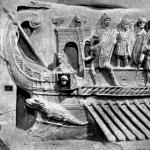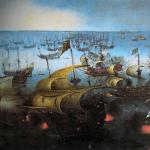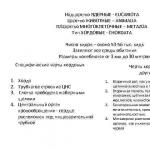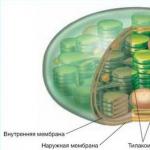Cells that contain chloroplasts. Structure and functions of chloroplasts
The main function of chloroplasts is to capture and convert light energy.
The composition of the membranes that form grana includes a green pigment - chlorophyll. It is here that the light reactions of photosynthesis occur - the absorption of light rays by chlorophyll and the conversion of light energy into the energy of excited electrons. Electrons excited by light, i.e., having excess energy, give up their energy to the decomposition of water and the synthesis of ATP. When water decomposes, oxygen and hydrogen are formed. Oxygen is released into the atmosphere, and hydrogen is bound by the protein ferredoxin.
Ferredoxin then oxidizes again, donating this hydrogen to a reducing agent called NADP. NADP goes into its reduced form - NADP-H2. Thus, the result of the light reactions of photosynthesis is the formation of ATP, NADP-H2 and oxygen, and water and light energy are consumed.
ATP accumulates a lot of energy - it is then used for synthesis, as well as for other needs of the cell. NADP-H2 is a hydrogen accumulator, and then easily releases it. Therefore, NADP-H2 is a chemical reducing agent. A large number of biosyntheses are associated specifically with reduction, and NADP-H2 acts as a supplier of hydrogen in these reactions.
Further, with the help of enzymes in the stroma of chloroplasts, i.e., outside the grana, dark reactions occur: hydrogen and the energy contained in ATP are used to reduce atmospheric carbon dioxide (CO2) and include it in the composition of organic substances. The first organic substance formed as a result of photosynthesis undergoes a large number of rearrangements and gives rise to the entire variety of organic substances synthesized in the plant and making up its body. A number of these transformations occur right there, in the stroma of the chloroplast, where there are enzymes for the formation of sugars, fats, as well as everything necessary for protein synthesis. The sugars can then either move from the chloroplast to other cell structures, and from there to other plant cells, or form starch, the grains of which are often seen in the chloroplasts. Fats are also deposited in chloroplasts, either in the form of drops, or in the form of simpler substances, precursors of fats, and exit the chloroplast.
Increasing the complexity of substances involves the creation of new chemical bonds and usually requires energy expenditure. Its source is still the same photosynthesis. The fact is that a significant proportion of substances formed as a result of photosynthesis again decomposes in the hyaloplasm and mitochondria (in the case of complete combustion, to substances that serve as the starting material for photosynthesis - CO2 and H2O). As a result of this process, which is essentially the reverse of photosynthesis, the energy previously accumulated in the chemical bonds of decomposed substances is released and - again through ATP - spent on the formation of new chemical bonds of synthesized molecules. Thus, a significant part of the products of photosynthesis is needed only to bind light energy and, turning it into chemical energy, use it for the synthesis of completely different substances. And only part of the organic matter formed during photosynthesis is used as building material for these syntheses.
Photosynthetic production (biomass) is colossal. For a year on the globe, it is about 1010 tons. Organic substances created by plants are the only source of life not only for plants, but also for animals, since the latter process ready-made organic substances, feeding either directly on plants or other animals that , in turn, feed on plants. Thus, photosynthesis is the basis of all modern life on Earth. All transformations of matter and energy in plants and animals represent rearrangements, recombinations and transfers of matter and energy of the primary products of photosynthesis. Photosynthesis is important for all living things because one of its products is free oxygen, which comes from a water molecule and is released into the atmosphere. It is believed that all the oxygen in the atmosphere was produced through photosynthesis. It is necessary for respiration for both plants and animals.
Chloroplasts are able to move around the cell. In weak light they are located under the cell wall that faces the light. At the same time, they turn their larger surface towards the light. If the light is too intense, they turn edge-on towards it and; line up along the walls parallel to the rays of light. At average illumination, chloroplasts occupy a position intermediate between the two extremes. In any case, one result is achieved: the chloroplasts find themselves in the most favorable lighting conditions for photosynthesis. Such movements of chloroplasts (phototaxis) are a manifestation of one of the types of irritability in plants.
Chloroplasts have a certain autonomy in the cell system. They have their own ribosomes and a set of substances that determine the synthesis of a number of their own proteins of the chloroplast. There are also enzymes, the work of which leads to the formation of lipids that make up the lamellae and chlorophyll. As we have seen, the chloroplast also has an autonomous system for producing energy. Thanks to all this, chloroplasts are able to independently build their own structures. There is even a view that chloroplasts (like mitochondria) originated from some lower organisms that settled in a plant cell and first entered into symbiosis with it, and then became its integral part, an organelle.
Plastids are organelles specific to plant cells (they are present in the cells of all plants, with the exception of most bacteria, fungi and some algae).
The cells of higher plants usually contain from 10 to 200 plastids 3-10 µm in size, most often having the shape of a biconvex lens. In algae, green plastids, called chromatophores, are very diverse in shape and size. They can have star-shaped, ribbon-shaped, mesh and other shapes.
There are 3 types of plastids:
- Colorless plastids - leucoplasts;
- painted - chloroplasts(Green colour);
- painted - chromoplasts(yellow, red and other colors).
These types of plastids are to a certain extent capable of transforming into each other - leucoplasts, with the accumulation of chlorophyll, turn into chloroplasts, and the latter, with the appearance of red, brown and other pigments, into chromoplasts.
Structure and functions of chloroplasts
Chloroplasts are green plastids containing a green pigment - chlorophyll.
The main function of chloroplast is photosynthesis.
Chloroplasts have their own ribosomes, DNA, RNA, fat inclusions, and starch grains. The outside of the chloroplast is covered with two protein-lipid membranes, and small bodies - grana and membrane channels - are immersed in their semi-liquid stroma (ground substance).

Grans(about 1 µm in size) - packets of round flat sacs (thylakoids), folded like a column of coins. They are located perpendicular to the surface of the chloroplast. The thylakoids of neighboring grana are connected to each other by membrane channels, forming a single system. The number of grana in chloroplasts varies. For example, in spinach cells, each chloroplast contains 40-60 grains.
Chloroplasts inside the cell can move passively, carried away by the current of the cytoplasm, or actively move from place to place.
- If the light is very intense, they turn edge-on towards the bright rays of the sun and line up along the walls parallel to the light.
- In low light, chloroplasts move to the cell walls facing the light and turn their large surface towards it.
- In average illumination they occupy an average position.
This achieves the most favorable lighting conditions for the photosynthesis process.
Chlorophyll
The grana of plant cell plastids contain chlorophyll, packaged with protein and phospholipid molecules to provide the ability to capture light energy.
The chlorophyll molecule is very similar to the hemoglobin molecule and differs mainly in that the iron atom located in the center of the hemoglobin molecule is replaced in chlorophyll by a magnesium atom.

There are four types of chlorophyll found in nature: a, b, c, d.
Chlorophylls a and b contain higher plants and green algae, diatoms contain a and c, red algae contain a and d.
Chlorophylls a and b have been studied better than others (they were first separated by the Russian scientist M.S. Tsvet at the beginning of the 20th century). In addition to them, there are four types of bacteriochlorophylls - green pigments of purple and green bacteria: a, b, c, d.
Most photosynthetic bacteria contain bacteriochlorophyll a, some contain bacteriochlorophyll b, and green bacteria contain c and d.
Chlorophyll has the ability to absorb solar energy very efficiently and transfer it to other molecules, which is its main function. Thanks to this ability, chlorophyll is the only structure on Earth that ensures the process of photosynthesis.
The main function of chlorophyll in plants is to absorb light energy and transfer it to other cells.
Plastids, like mitochondria, are characterized to some extent by autonomy within the cell. They reproduce by fission.
Along with photosynthesis, the process of protein biosynthesis occurs in plastids. Due to their DNA content, plastids play a role in the transmission of traits by inheritance (cytoplasmic inheritance).
Structure and functions of chromoplasts
Chromoplasts belong to one of the three types of plastids of higher plants. These are small, intracellular organelles.
Chromoplasts have different colors: yellow, red, brown. They give a characteristic color to ripe fruits, flowers, and autumn foliage. This is necessary to attract pollinating insects and animals that feed on fruits and distribute seeds over long distances.

The structure of the chromoplast is similar to other plastids. The inner shells of the two are poorly developed, sometimes completely absent. The protein stroma, DNA and pigment substances (carotenoids) are located in a limited space.
Carotenoids are fat-soluble pigments that accumulate in the form of crystals.
The shape of chromoplasts is very diverse: oval, polygonal, needle-shaped, crescent-shaped.
The role of chromoplasts in the life of a plant cell is not fully understood. Researchers suggest that pigment substances play an important role in redox processes and are necessary for the reproduction and physiological development of cells.
Structure and functions of leukoplasts
Leukoplasts are cell organelles in which nutrients accumulate. The organelles have two shells: a smooth outer shell and an inner one with several protrusions.
Leukoplasts turn into chloroplasts in the light (for example, green potato tubers); in their normal state they are colorless.
The shape of the leukoplasts is spherical and regular. They are found in the storage tissue of plants, which fills the soft parts: the core of the stem, root, bulbs, leaves.

The functions of leukoplasts depend on their type (depending on the accumulated nutrient).
Types of leukoplasts:
- Amyloplasts accumulate starch and are found in all plants, since carbohydrates are the main food product of the plant cell. Some leucoplasts are completely filled with starch; they are called starch grains.
- Elaioplasts produce and store fats.
- Proteinoplasts contain proteins.
Leukoplasts also serve as an enzymatic substance. Under the influence of enzymes, chemical reactions proceed faster. And in an unfavorable period of life, when photosynthesis processes are not carried out, they break down polysaccharides into simple carbohydrates, which plants need to survive.
Photosynthesis cannot occur in leucoplasts because they do not contain grains or pigments.
Plant bulbs, which contain many leucoplasts, can tolerate long periods of drought, low temperatures, and heat. This is due to large reserves of water and nutrients in the organelles.
The precursors of all plastids are proplastids, small organelles. It is assumed that leuco- and chloroplasts are capable of transforming into other species. Ultimately, after fulfilling their functions, chloroplasts and leucoplasts become chromoplasts - this is the last stage of plastid development.
It is important to know! Only one type of plastid can be present in a plant cell at a time.
Summary table of the structure and functions of plastids
| Properties | Chloroplasts | Chromoplasts | Leukoplasts |
|---|---|---|---|
| Structure | Double-membrane organelle, with grana and membranous tubules | Organelle with an undeveloped internal membrane system | Small organelles found in parts of the plant hidden from light |
| Color | Greens | Multicolored | Colorless |
| Pigment | Chlorophyll | Carotenoid | Absent |
| Form | Round | Polygonal | Globular |
| Functions | Photosynthesis | Attracting potential plant distributors | Nutrient supply |
| Replaceability | Transform into chromoplasts | Do not change, this is the last stage of plastid development | Transform into chloroplasts and chromoplasts |
CHLOROPLASTS CHLOROPLASTS
(from the Greek chloros - green and plastos - fashioned), intracellular organelles (plastids) of plants, in which photosynthesis occurs; Thanks to chlorophyll, they are colored green. Found in various cells. tissues of above-ground plant organs, especially abundant and well developed in leaves and green fruits. Dl. 5-10 microns, width. 2-4 microns. In the cells of higher plants, X. (usually there are 15-50 of them) have a lens-shaped, round or ellipsoidal shape. Much more diverse than X., called. chromatophores in algae, but their number is usually small (from one to several). X. are separated from the cytoplasm by a double membrane with selectivity. permeability; internal its part, growing into the matrix (stroma), forms a basic system. X. structural units in the form of flattened bags - thylakoids, in which pigments are localized: the main ones are chlorophylls and the auxiliary ones are carotenoids. Groups of disc-shaped thylakoids, connected to each other in such a way that their cavities are continuous, form (like a stack of coins) grana. The number of grains in X. higher plants can reach 40-60 (sometimes up to 150). Thylakoids of the stroma (so-called frets) connect the grana with each other. X. contain ribosomes, DNA, enzymes and, in addition to photosynthesis, carry out the synthesis of ATP from ADP (phosphorylation), the synthesis and hydrolysis of lipids, assimilative starch and proteins deposited in the stroma. X. also synthesizes enzymes that carry out the light reaction and thylakoid membrane proteins. Own genetic apparatus and specific The protein synthesizing system determines the autonomy of X. from other cellular structures. Each X. is believed to develop from a proplastid, which is capable of replicating by division (this is how their number in the cell increases); mature X. are sometimes also capable of replication. With the aging of leaves and stems and the ripening of fruits, X. due to the destruction of chlorophyll, lose their green color, turning into chromoplasts. It is believed that X. occurred through the symbiogenesis of cyanobacteria with ancient nuclear heterotrophic algae or protozoa.


.(Source: “Biological Encyclopedic Dictionary.” Editor-in-chief M. S. Gilyarov; Editorial Board: A. A. Babaev, G. G. Vinberg, G. A. Zavarzin and others - 2nd ed., corrected - M.: Sov. Encyclopedia, 1986.)
chloroplastsOrganelles of plant cells containing the green pigment chlorophyll; view plastid. They have their own genetic apparatus and protein synthesis system, which provides them with relative “independence” from the cell nucleus and other organelles. The main physiological process of green plants is carried out in chloroplasts - photosynthesis. In addition, they synthesize the energy-rich compound ATP, proteins, and starch. Chloroplasts are found mainly in leaves and green fruits. As leaves age and fruits ripen, chlorophyll is destroyed and chloroplasts turn into chromoplasts.
.(Source: “Biology. Modern illustrated encyclopedia.” Chief editor A. P. Gorkin; M.: Rosman, 2006.)
See what "CHLOROPLASTS" are in other dictionaries:
In moss cells Plagiomnium affine Chloroplasts (from the Greek ... Wikipedia
- (from the Greek chloros green and plastos sculpted formed), intracellular organelles of a plant cell in which photosynthesis occurs; colored green (they contain chlorophyll). Own genetic apparatus and... ... Big Encyclopedic Dictionary
Bodies contained in plant cells, colored green and containing chlorophyll. In higher plants, chlorophylls have a very definite shape and are called chlorophyll grains; Algae have a varied form and they are called chromatophores or... Encyclopedia of Brockhaus and Efron
Chloroplasts- (from the Greek chloros green and plastos fashioned, formed), intracellular structures of a plant cell in which photosynthesis occurs. They contain the pigment chlorophyll, which colors them green. In the cell of higher plants there are from 10 to ... Illustrated Encyclopedic Dictionary
- (gr. chloros green + lastes forming) green plastids of a plant cell containing chlorophyll, carotene, xanthophyll and involved in the process of photosynthesis cf. chromoplasts). New dictionary of foreign words. by EdwART, 2009. chloroplasts [gr.... ... Dictionary of foreign words of the Russian language
- (from the Greek chlorós green and plastós fashioned, formed) intracellular organelles of a plant cell Plastids in which photosynthesis occurs. They are colored green due to the presence of the main pigment of photosynthesis... Great Soviet Encyclopedia
Ov; pl. (unit chloroplast, a; m.). [from Greek chlōros pale green and plastos sculpted] Botan. Bodies in the protoplasm of plant cells containing chlorophyll and participating in the process of photosynthesis. Chlorophyll concentration in chloroplasts. * * *… … encyclopedic Dictionary
Bodies contained in plant cells, colored green and containing chlorophyll. In higher plants, X. have a very definite shape and are called chlorophyll grains (see); Algae have a variety of shapes and they are called... ... Encyclopedic Dictionary F.A. Brockhaus and I.A. Ephron
Mn. Green plastids of a plant cell containing chlorophyll, carotene and participating in the process of photosynthesis. Ephraim's explanatory dictionary. T. F. Efremova. 2000... Modern explanatory dictionary of the Russian language by Efremova
- (from the Greek chloros green and plastоs sculpted, formed), grows intracellular organelles. cells in which photosynthesis occurs; colored green (they contain chlorophyll). Own genetic apparatus and protein synthesizing... ... Natural science. encyclopedic Dictionary
Its shell consists of two membranes - external and internal, between which there is an intermembrane space. Inside the chloroplast, by detaching from the inner membrane, a complex thylakoid structure is formed. The gel-like contents of the chloroplast are called stroma.
Each thylakoid is separated from the stroma by a single membrane. The interior space of the thylakoid is called the lumen. Thylakoids in the chloroplast they are combined into stacks - grains. The number of grains varies. They are connected to each other by special elongated thylakoids - lamellae. An ordinary thylakoid looks like a rounded disk.
The stroma contains the chloroplast's own DNA in the form of a circular molecule, RNA and prokaryotic-type ribosomes. Thus, it is a semi-autonomous organelle capable of independently synthesizing some of its proteins. It is believed that in the process of evolution, chloroplasts originated from cyanobacteria that began to live inside another cell.
The structure of the chloroplast is determined by the function of photosynthesis. Reactions associated with it occur in the stroma and on thylakoid membranes. In the stroma - the reactions of the dark phase of photosynthesis, on the membranes - the light phase. Therefore, they contain different enzymatic systems. The stroma contains soluble enzymes involved in the Calvin cycle.
Thylakoid membranes contain pigments chlorophylls and carotenoids. All of them are involved in capturing solar radiation. However, they catch different spectra. The predominance of one or another type of chlorophyll in a certain group of plants determines their shade - from green to brown and red (in a number of algae). Most plants contain chlorophyll a.
The structure of the chlorophyll molecule consists of a head and a tail. The carbohydrate tail is immersed in the thylakoid membrane, and the head faces the stroma and is located in it. The energy of sunlight is absorbed by the head, leading to the excitation of an electron, which is picked up by carriers. A chain of redox reactions is started, ultimately leading to the synthesis of a glucose molecule. Thus, the energy of light radiation is converted into the energy of chemical bonds of organic compounds.
Synthesized organic substances can accumulate in chloroplasts in the form of starch grains, and are also removed from it through the membrane. There are also fat droplets in the stroma. However, they are formed from lipids of destroyed thylakoid membranes.
In the cells of autumn leaves, chloroplasts lose their typical structure, turning into chromoplasts, in which the internal membrane system is simpler. In addition, chlorophyll is destroyed, causing carotenoids to become noticeable, giving the foliage yellow-red hues.
The green cells of most plants usually contain many chloroplasts, shaped like a ball slightly elongated in one direction (volume ellipse). However, a number of algae cells may contain one huge chloroplast of a bizarre shape: ribbon-shaped, star-shaped, etc.
A cell is a complex structure made up of many components called organelles. Moreover, the composition plant cell slightly different from animals, and the main difference lies in the presence plastids.
In contact with
Description of cellular elements
What cell components are called plastids. These are structural cell organelles that have a complex structure and functions that are important for the life of plant organisms.
Important! Plastids are formed from proplastids, which are located inside meristem or educational cells and are much smaller in size than the mature organelle. They are also divided, like bacteria, into two halves by constriction.
Which ones do they have? plastids structure It is difficult to see under a microscope; thanks to the dense shell, they are not translucent.
However, scientists were able to find out that this organoid has two membranes, inside it is filled with stroma, a liquid similar to cytoplasm.
Folds of the inner membrane, stacked, form granules that can be connected to each other.
Also present inside are ribosomes, lipid droplets, and starch grains. Plastids, especially chloroplasts, also have their own molecules.
Classification
They are divided into three groups according to color and functions:
- chloroplasts,
- chromoplasts,
- leukoplasts.
Chloroplasts
The most deeply studied ones are green in color. Contained in plant leaves, sometimes in stems, fruits and even roots. In appearance they look like rounded grains 4-10 micrometers in size. Small size and large quantity significantly increases the working surface area.
They may vary in color, depending on the type and concentration of pigment they contain. Basic pigment - chlorophyll, xanthophyll and carotene are also present. In nature, there are 4 types of chlorophyll, designated by Latin letters: a, b, c, e. The first two types contain cells of higher plants and green algae; diatoms have only varieties - a and c.
Attention! Like other organelles, chloroplasts are capable of aging and destruction. The young structure is capable of division and active work. Over time, their grains break down and the chlorophyll disintegrates.
Chloroplasts perform an important function: inside them the process of photosynthesis occurs— conversion of sunlight into the energy of chemical bonds of forming carbohydrates. At the same time, they can move along with the flow of cytoplasm or actively move on their own. So, in low light they accumulate near the walls of the cell with a large amount of light and turn towards it with a larger area, and in very active light, on the contrary, they stand edge-on.
Chromoplasts
 They replace destroyed chloroplasts and come in yellow, red and orange shades. The color is formed due to the content of carotenoids.
They replace destroyed chloroplasts and come in yellow, red and orange shades. The color is formed due to the content of carotenoids.
These organelles are found in the leaves, flowers and fruits of plants. The shape can be round, rectangular or even needle-shaped. The structure is similar to chloroplasts.
Main function – coloring flowers and fruits, which helps attract pollinating insects and animals that eat the fruits and thereby contribute to the spread of plant seeds.
Important! Scientists speculate about the role chromoplasts in the redox processes of the cell as a light filter. The possibility of their influence on the growth and reproduction of plants is considered.
Leukoplasts
Data plastids have differences in structure and functions. The main task is to store nutrients for future use, so they are found mainly in the fruits, but can also be in the thickened and fleshy parts of the plant:
- tubers,
- rhizomes,
- root vegetables,
- bulbs and others.
 Colorless color does not allow you to select them in the structure of the cell, however, leukoplasts are easy to see when a small amount of iodine is added, which, interacting with starch, turns them blue.
Colorless color does not allow you to select them in the structure of the cell, however, leukoplasts are easy to see when a small amount of iodine is added, which, interacting with starch, turns them blue.
The shape is close to round, while the membrane system inside is poorly developed. The absence of membrane folds helps the organelle in storing substances.
Starch grains increase in size and easily destroy the internal membranes of the plastid, as if stretching it. This allows you to store more carbohydrates.
Unlike other plastids, they contain a DNA molecule in a shaped form. At the same time, accumulating chlorophyll, leucoplasts can transform into chloroplasts.
When determining what function leucoplasts perform, it is necessary to note their specialization, since there are several types that store certain types of organic matter:
- amyloplasts accumulate starch;
- oleoplasts produce and store fats, while the latter can be stored in other parts of the cells;
- proteinoplasts “protect” proteins.
 In addition to accumulation, they can perform the function of breaking down substances, for which there are enzymes that are activated when there is a shortage of energy or building material.
In addition to accumulation, they can perform the function of breaking down substances, for which there are enzymes that are activated when there is a shortage of energy or building material.
In such a situation, enzymes begin to break down stored fats and carbohydrates into monomers so that the cell receives the necessary energy.
All varieties of plastids, despite structural features, have the ability to transform into each other. Thus, leucoplasts can transform into chloroplasts; we see this process when potato tubers turn green.
At the same time, in autumn, chloroplasts turn into chromoplasts, as a result of which the leaves turn yellow. Each cell contains only one type of plastid.
Origin
There are many theories of origin, the most substantiated among them are two:
- symbiosis,
- absorption.
The first considers cell formation as a process of symbiosis occurring in several stages. During this process, heterotrophic and autotrophic bacteria unite, receiving mutual benefits.
The second theory considers the formation of cells through the absorption of smaller ones by larger organisms. However, they are not digested; they are integrated into the structure of the bacterium, performing their function within it. This structure turned out to be convenient and gave the organisms an advantage over others.
Types of plastids in a plant cell
Plastids - their functions in the cell and types
Conclusion
Plastids in plant cells are a kind of “factory” where production associated with toxic intermediates, high energy and free radical transformation processes takes place.





